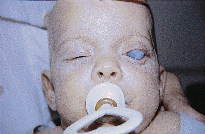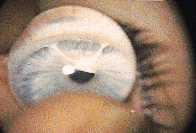Children are never too young for glaucoma checks
 Congenital glaucoma: Infant with unilateral buphthalmos.
Congenital glaucoma: Infant with unilateral buphthalmos.
PORTLAND, Ore.—According to Gerhard W. Cibis, MD, glaucoma in children is frequently missed because no one thinks to check the intraocular pressure (IOP) of an 8-year-old.
Cibis, clinical professor of ophthalmology at the University of Missouri and chief of ophthalmology at Children's Mercy Hospital, Kansas City, discussed pediatric glaucoma here at the American Optometric Association meeting.
"Glaucoma in children is categorized in two groups," Cibis said. "Truly congenital glaucoma occurs in the first year of life, while juvenile glaucoma—although somewhat rare—shows up after 10 years of age and is usually hereditary."
ODs should check thoroughly for symptoms such as elevated IOP, anomalous chamber angles, foreshortened trabecular meshwork and enlarged cornea (in newborns, a normal cornea measures 10-10.5 mm). Look at the family history, as well.
Differentiate epithelial, stromal edema
"If the cornea is more than 12 mm, it is probably abnormal," Cibis said. "Measure it and watch it. True infantile glaucoma is developmental, often autosomal recessive, occurring in every one to five per 10,000 live births."
It is important to differentiate between epithelial and stromal edema in the diagnosis because many other dystrophies can occur. Epithelial edema will occur with glaucoma, while stromal edema will occur with other dystrophies.
"Look for cupping," Cibis said. "Cups can be reversed in infants because the optic disc tissue is so flexible. Also, check axial length, which can be just as helpful as corneal diameter measurements."
Repeat examinations may be necessary, and it is not uncommon to check a child up to four times before developing a diagnosis. Cibis uses a hand-held applanation, and measurements can be taken early under anesthesia.
If the OD is unable to check the child, the patient should be referred to a specialist who uses anesthesia.
With infantile glaucoma, the solution is always surgery, so ODs should refer the patient if that diagnosis is suspected.
Medical therapy may not work
 Congenital chamber angle anomaly: A case of pupil-iris-lens-membrane with goniodysgenesis.
Congenital chamber angle anomaly: A case of pupil-iris-lens-membrane with goniodysgenesis.
Because pediatric glaucoma is an anatomic abnormality, medical therapy does not work and is not the primary course of action. Beta-blockers can work, but not well enough. It takes, on average, two or three surgeries to get the glaucoma under control, and there is a 80% success rate, says Cibis. Unlike adults, surgery comes first, then medical therapy.
In cases of juvenile glaucoma, medical therapy will work.
Glaucoma can occur with Down, Lowe and Sturge-Weber syndromes. Sixty percent of patients with Lowe syndrome have glaucoma by 6 years of age.
With Sturge-Weber, a more common disease, a purple blood vessel birthmark on the face, which involves the upper eyelid, may increase the risk for glaucoma. Pressure should be checked and a comparison made with the other eye.
"Metabolic disorders in patients may also produce cloudy corneas," Cibis said, "And these patients can also get glaucoma."
While not every cloudy cornea means glaucoma, ODs should be aware of the possibilities in children and should measure corneal diameter and check tension early to get a basis for comparison as the child develops.
